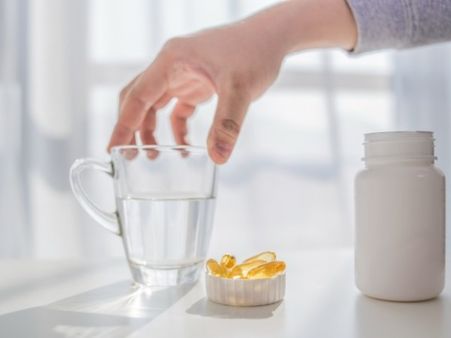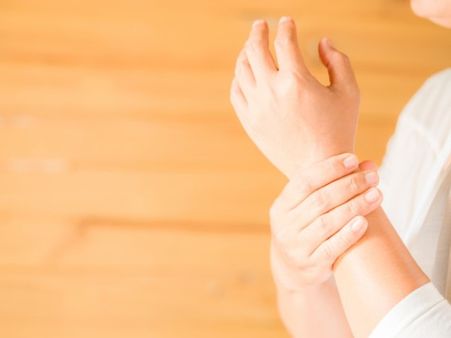Just In
- 14 hrs ago

- 14 hrs ago

- 17 hrs ago

- 18 hrs ago

Don't Miss
- Movies
 Pavi Caretaker Box Office Collection Day 1 Prediction: Dileep's Movie Expected To Open Strongly
Pavi Caretaker Box Office Collection Day 1 Prediction: Dileep's Movie Expected To Open Strongly - Sports
 Who Won Yesterday's IPL Match 41? SRH vs RCB, IPL 2024 on April 25: Royal Challengers Bangalore End Losing Streak
Who Won Yesterday's IPL Match 41? SRH vs RCB, IPL 2024 on April 25: Royal Challengers Bangalore End Losing Streak - Finance
 Bajaj Group Stock Declares Rs. 60/Share Dividend: Buy Ahead of Record Date On 28 June?
Bajaj Group Stock Declares Rs. 60/Share Dividend: Buy Ahead of Record Date On 28 June? - News
 MEA Dismisses US Human Rights Report On Manipur As 'Biased And Misinformed'
MEA Dismisses US Human Rights Report On Manipur As 'Biased And Misinformed' - Automobiles
 Royal Enfield Unveils Revolutionary Rentals & Tours Service: Check Out All Details Here
Royal Enfield Unveils Revolutionary Rentals & Tours Service: Check Out All Details Here - Technology
 Elon Musk’s X Is Launching a TV App Similar to YouTube for Watching Videos
Elon Musk’s X Is Launching a TV App Similar to YouTube for Watching Videos - Education
 AICTE introduces career portal for 3 million students, offering fully-sponsored trip to Silicon Valley
AICTE introduces career portal for 3 million students, offering fully-sponsored trip to Silicon Valley - Travel
 Escape to Kalimpong, Gangtok, and Darjeeling with IRCTC's Tour Package; Check Itinerary
Escape to Kalimpong, Gangtok, and Darjeeling with IRCTC's Tour Package; Check Itinerary
A Nutritionist Explains How To Ensure That We Have Sufficient Vitamin D During Monsoons
Have you been feeling lethargic, short of energy, facing mood swings, muscle pains, or seeing a lot of hair loss recently? The sunshine vitamin or Vit D could be the reason behind it. In Monsoons, when skin exposure to sunlight is minimal, we are more prone to this vitamin deficiency.

Vitamin D is often referred to as the sunshine vitamin as your body makes it by itself -- but only after skin exposure to sufficient sunlight. And if you did not stock up sunlight during summers, you are likely to be deficient in this vitamin now, since the sunlight is minimal due to the dark clouds of the monsoons [1][2].
Interestingly, Vitamin D is not a vitamin but a hormone that communicates within your body through neurons. Vitamin D is required for the regulation of the minerals calcium and phosphorus found in the body. These nutrients are needed to keep bones, teeth and muscles healthy. A lack of vitamin D can lead to bone deformities such as rickets in children, and bone pain caused by a condition called osteomalacia in adults. It also plays a vital role in maintaining proper bone structure. Vitamin D helps regulate the immune system and even in the life cycle of human cells [3][4].
Vitamin D deficiency has been linked to breast cancer, colon cancer, prostate cancer, heart disease, depression, weight gain, and other maladies. People with higher levels of vitamin D have a lower risk of diseases. An estimated one billion people worldwide are either vitamin D insufficient or deficient [5].

What Limits Vitamin D Production?
- Latitude
- A traditional dress that covers most of the body [6]
- Season
- Sun avoidance
- Sunscreen protection
- Skin pigmentation
- Gastrointestinal, hepatic, and renal disease may be related to low vitamin D levels

How To Get The Required Dose Of Vitamin D?
There are three ways to get Vitamin D and they are as follows [7]:
- You can expose your skin to sufficient sunlight and store Vitamin D for a few months
- You can eat a diet rich in Vitamin D
- You can supplement your diet with Vitamin D

Sun Exposure
This is an easy and reliable way for most people to get vitamin D. Just six days of casual sunlight exposure without sunscreen can make up for 49 days of no sunlight exposure. Exposure of the hands, face, arms, and legs to sunlight 2-3 times a week for 20 minutes will cause the skin to produce enough vitamin D. The necessary exposure time varies with age, skin type, season, time of day, etc.
Body fat acts like a kind of storage battery for vitamin D. During periods of sunlight, vitamin D is stored in fat and then released when sunlight is gone [8].Dark skin absorbs less sunlight, so people with dark skin do not get as much vitamin D from sun exposure as do light-skinned people [9].

Diet Rich In Vitamin D
This vitamin is found in a small number of foods and these are mainly non-vegetarian sources [10].
- Fatty fish - Like salmon, sardines, herring and mackerel
- Red meat
- Liver
- Egg yolks
- Mushrooms
- Fortified foods- like dairy products and breakfast cereals

Vitamin D Supplementation
Supplementation is safe and inexpensive, but vitamin D deficiency often remains undiagnosed or is undertreated. Supplementation should be done only after checking the level of deficiency in a blood test. The dosage of supplements should be prescribed by a qualified doctor. Once the supplementation is completed, it is important to get a blood test done again to check if the deficiency is completed [11].
Important note: One should never self-medicate themselves as an excess of the supplements can prove to be toxic.

What Happens If I Take Too Much Vitamin D?
Taking too many vitamin D supplements over a long period can cause too much calcium to build up in the body (hypercalcaemia). This can weaken the bones and damage the kidneys and the heart.
You cannot overdose on vitamin D through exposure to sunlight. But always remember to cover up or protect your skin if you're out in the sun for long periods to reduce the risk of skin damage and skin cancer [12].
Symptoms Of Vitamin D Deficiency
Lower immunity: Vitamin D's interacts with the cells that are responsible for fighting infection. Hence it keeps your immune system strong, so you're able to fight off viruses and bacteria that cause illness [13].
Fatigue and tiredness: Feeling tired can have many causes, and a deficiency of this fat-soluble vitamin can be one of them.
Loss in bone density: Vit D is responsible for the assimilation of calcium in the bones. Hence, a deficiency can lead to weaker bones, leading to joint pains and back pain.
Impaired wound healing: severe vitamin D deficiency leads to higher levels of inflammatory markers that can reduce wound healing time.
Hair loss: Many factors, especially stress, is responsible for hair loss. However, few studies have stated a deficiency of Vit D for hair loss. This vitamin is also used to treat alopecia.
Muscle pain: There is a link between chronic pain and low blood levels of vitamin D, which may be due to the interaction between the vitamin and pain-sensing nerve cells.
Respiratory infection: Vitamin D deficiency is linked to respiratory tract infections like colds, bronchitis and pneumonia [14].
Depression: Sufficient Vit D in the body improves depression, including seasonal depression that occurs during the colder months [15].

On A Final Note...
Vitamin
D
deficiency
is
incredibly
common,
and
most
people
are
unaware
of
it.
That's
because
the
symptoms
are
often
subtle
and
non-specific,
meaning
that
it's
hard
to
know
if
they're
caused
by
low
vitamin
D
levels
or
something
else.
If
you
think
you
may
have
a
deficiency,
it's
important
that
you
speak
to
your
doctor
and
get
your
blood
levels
measured.
Fortunately,
a
vitamin
D
deficiency
is
usually
easy
to
fix.
-
 healthMonsoon Continues In Many Parts Of India: Can Rain Trigger Depression?
healthMonsoon Continues In Many Parts Of India: Can Rain Trigger Depression? -
 healthSeasonal Illnesses On A Rise: Are You Following The Right Prevention Methods?
healthSeasonal Illnesses On A Rise: Are You Following The Right Prevention Methods? -
 home n gardenHow To Keep Coriander Leaves Fresh? Tips For Every Season In Indian Homes
home n gardenHow To Keep Coriander Leaves Fresh? Tips For Every Season In Indian Homes -
 beautyUnderstand And Overcome Dandruff: A Common Menace in Indian Climate
beautyUnderstand And Overcome Dandruff: A Common Menace in Indian Climate -
 pregnancy parentingMonsoon Related Respiratory Illnesses In Children: Identifying, Treating And Preventing
pregnancy parentingMonsoon Related Respiratory Illnesses In Children: Identifying, Treating And Preventing -
 yoga spirituality10 Magnificent Temples In India To Visit During Monsoon
yoga spirituality10 Magnificent Temples In India To Visit During Monsoon -
 home n gardenHow To Clean Tiles During Monsoon In India
home n gardenHow To Clean Tiles During Monsoon In India -
 healthSpice Up Your Diet To Combat Monsoon Hair Loss
healthSpice Up Your Diet To Combat Monsoon Hair Loss -
 healthConjunctivitis Alert: Is Eye Flu Dangerous? Does It Spread By Looking?
healthConjunctivitis Alert: Is Eye Flu Dangerous? Does It Spread By Looking? -
 beautyMonsoon Hair Care: 4 Reasons Why You Need To Take Extra Care Of Your Scalp
beautyMonsoon Hair Care: 4 Reasons Why You Need To Take Extra Care Of Your Scalp -
 beautyBanish Flaky Skin From Your Lips In No Time With These Natural Tips
beautyBanish Flaky Skin From Your Lips In No Time With These Natural Tips -
 healthMonsoon Illness Prevention: Health Department Advises Everyone To Take Weekly ‘Dry Day’
healthMonsoon Illness Prevention: Health Department Advises Everyone To Take Weekly ‘Dry Day’


 Click it and Unblock the Notifications
Click it and Unblock the Notifications



